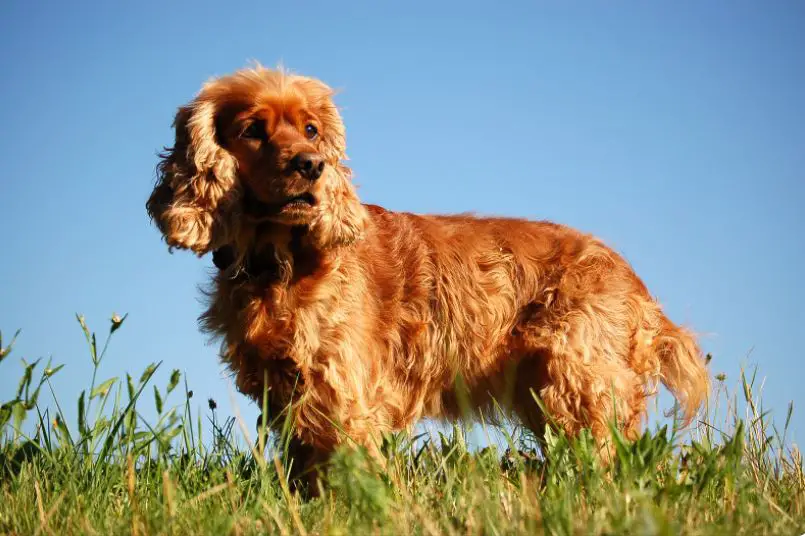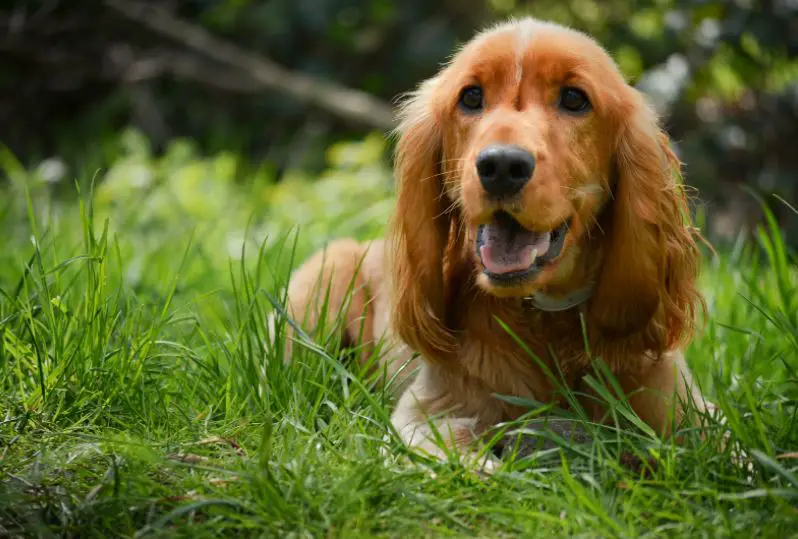Beagle vs. Cocker Spaniel Breed Guide – What Is The Best Breed For You

If you are an inexperienced or first-time owner, then either breed is a good choice. Both of these breeds like children, and are good companions.
Read on to find out what other comparisons are between a Beagle and Cocker Spaniel before you decide.
Key Similarities
Both of these dogs are purebreds which means that the breeder you acquire them from should have the registration history of both parents. Both breeds are overall friendly and can live in an apartment if necessary. The Beagle and the Cocker Spaniel have a medium energy level. Plus, both dogs aren’t necessarily the fighting kind. They are more lovers than fighters.
Key Differences
The Beagle can be stubborn, while the Cocker Spaniel is affectionate. The Beagle is easier to groom, while the Cocker Spaniel has a higher grooming requirement. Plus, the Beagle is more independent and is easily distracted. The Cocker Spaniel is less independent but is more patient and focused.
Pros of Owning a Beagle
If you choose to own a Beagle, you will find that your pet is a low-maintenance dog. These dogs were bred for hunting, so this is the dog for you if you’re a hunter. These dogs are lively, curious, and love to be around people
Pros of Owning a Cocker Spaniel
These dogs love to snuggle up to their owners and enjoy the attention. A Cocker Spaniel can adapt to living anywhere you do as long as he exercises daily. Your dog will be easy-going, affectionate, and gentle but lively.
All About the Beagle

Beagles are from the U.K. and were bred to hunt hare and deer. “Beagle” is thought to be French for “loudmouth.”
The name fits perfectly because of the baying and howling a beagle does when he catches a scent.
All About the Cocker Spaniel

The Cocker Spaniel is descended from the Spaniel, one of the oldest dog breeds. The Spaniel breeds came from Spain and were all sizes and shaped.
The types of spaniels were land, water, springer, field spaniels, and Sussex.
History:
These dogs were brought over to the United States during the 20th century. The breed found favor with families quickly.
They are also becoming popular as mixed breeds, for example, when mixed with a corgi.
Beagles also work as scent detection dogs. They can be found in airports sniffing illegal food items, drugs, and weapons.
Size and appearance:
Beagles can come in two sizes but never taller than 15 inches. Your Beagle can be either 13 inches height to the shoulder or 15 inches height to the shoulder.
The smaller type of Beagle weighs between 22 to 30 pounds. The larger Beagle can weigh up to 35 pounds.
A beagle can look similar to a Foxhound but are smaller. The Beagle and the Foxhound share strong jaws, floppy ears, tricolor coats with medium-length fur.
Beagles are muscular, thick dogs with straight backs and deep chests. Their tails are relatively long, carried high, and usually always white. These dogs have domed heads with broad noses and a square-shaped muzzle. The Beagles ears are set low on the head and floppy.
The most common coat colors on a Beagle are black, tan, and white. But there is a range of other colors that their coat can be as well. These colors are lemon and white, orange and white, brown and white, red and white, chocolate tricolor, and tan and white.
Lifespan:
Your Beagle can live between 10-15 years when taken care of properly.
Guard dog or family pet:
A Beagle does not make a good guard dog because every new person is their friend.
Your pet can be trained to bark when someone is knocking, but then the person will be a friend for life when they enter the house.
History:
The Spaniel breeds came from Spain and were all sizes and shaped. The types of spaniels were land, water, springer, field spaniels, and Sussex.
All of these spaniels were bred for different hunting duties. The dog’s size was the main point of difference between all these dogs.
The Cocker Spaniel was used to retrieve and flush out small game such as woodcock, pheasant, and quail. In 1946, both the American Cocker Spaniel and the English Cocker Spaniel were recognized officially by the AKC as separate breeds.
Size and appearance:
Cocker Spaniels have incredibly expressive faces and stand out in a crowd. However, their tail keeps wagging, their eyes are dark, and big floppy ears.
Your Cocker Spaniel’s weight will be between 24-28 pounds, with the male being 15 inches at the withers and the female being 14 inches. The head is graceful and round with a broad square muzzle. The ears are feathered long, and the dog’s back slopes towards the tail. There is feathering on the ears and the legs, underside, and chest. Most of the time, the tail is docked.
There are a variety of colors with Cocker Spaniels. The colors can be solid black, tan, or red. Other coats are bi-colored and tri-colored. The coats can be black and white, black and tan, or black and white with tan flecks.
The AKC has the Cocker Spaniel divided into three varieties for show. The divisions are parti-color, black, or ASCOB, which stands for Any Solid Color Other Than Black.
Lifespan:
The life expectancy of your Cocker Spaniel is between 14 to 16 years.
Guard dog or family pet?
The guarding instinct is very low in this breed.
You can train them to bark when someone is at the door, but that’s about it. These dogs are friendly, gentle dogs who make great family pets.
Beagle In More Detail

Temperament And Behavior:
Your Beagle will love and expect attention. This breed is an excellent companion dog and is quite animated. Beagles get along well with kids and other pets and prefer to be around others.
If left alone too long, your may howl and become destructive. Because this breed is so stubborn and bark excessively, housebreaking may be an issue unless you’re persistent and have patience.
This breed was bred to hunt, so your dog will be naturally curious about everything. However, your dog can be a handful since he will be led by his nose. In addition, beagles are prone to roaming, so having a sturdy fence around your yard is essential.
Training And Behavior:
Beagles can be more challenging to train because of having such an independent nature. But because they are intelligent dogs, positive and reward-based training methods will get the best results.
In addition, this breed responds well to clicker training and using food to teach commands.
Keep in mind that if your dog becomes scent-focused, he can lose interest in anything you’re trying to teach him. He can follow his nose right out of your yard and become lost. Always be sure to train your dog on a leash so he can’t develop the idea that leaving in the middle of a training session is acceptable.
Exercise needs:
If you give your dog about an hour or so of exercise a day, it should work well. If you take your dog on two walks a day, it should keep him happy and fit. If possible, your Beagle should have access to a fenced-in yard where he can run around off-leash.
Shedding, grooming, and maintenance:

Your Beagle will shed low to medium even with his short sleek coat. Your pup will need to be brushed every couple of days to remove loose hair.
Plus, this breed does have a distinct doggy smell, and your dog will love to roll in disgusting smelly stuff. So, bathing frequently will be a must.
Because your dog’s ears hang down, he’ll be suspectable to ear infections. So first, clean your pet’s ears with a vet-approved ear cleaning solution. Then, use a puffy cotton ball to wipe out your dog’s ear. Don’t use a Q-tip, and don’t go any deeper than the first knuckle of your finger into your dog’s ear.
Trim your Beagle’s nails every few weeks to keep him comfortable. Plus, it protects your floor from being damaged. If you can’t do it, you can have your vet do it or a professional groomer.
Health Issues:
As with all dogs, there could be some health issues that crop up according to your dog’s breed. He could get Cherry Eye, Chinese Beagle Syndrome, Distichiasis, Epilepsy, Glaucoma, Hip Dysplasia, Hypothyroidism, Intervertebral Disk Disease, Patellar Luxation, and Progressive Retinal Atrophy.
When you acquire your puppy from a breeder, always ask to be shown a valid veterinary screening certificate for both parents and grandparents. If the screening is clear, your dog shouldn’t inherit any congenital health issues.
Quick Facts:
Beagles are prone to obesity, so monitor their food intake. Also, keep trash cans and food on counters out of reach. Your dog will grab either at the first opportunity.
A Beagle’s price should cost anywhere between $500 to $2,000 if bought from a reputable breeder. Don’t buy one from a puppy mill because most puppies are unhealthy.
Beagles love to dig and, if left alone, can decimate a garden or a front lawn.
A Beagle is one of the most vocal dog breeds around, with three different barks. First, the standard bark, a yodel bark called a bay used for hunting, and the last is a howl.
Cocker Spaniel In More Detail

Temperament And Behavior:
The Cocker Spaniel breed is easy-going, affectionate, gentle, but lively. These dogs are good with children and usually non-aggressive toward other people and pets.
However, the Cocker Spaniel became one of the most sought-after dogs due to its popularity. This has led to problems within the breed. Backyard breeders and puppy mills have overbred Cocker Spaniels. This has resulted in negative characteristics and genetic problems from unscreened stock.
Always purchase your puppy from a reputable breeder who can show you the profile of the parents and grandparents.
Training and obedience:
The reports on training and housebreaking are mixed. Some owners say that the breed is easy to train. On the other hand, some owners say that the dogs are obedient but stubborn when housebreaking.
Your pet will be sweet, playful, and gentle with kids and other animals when properly socialized. These dogs love to play fetch and love to play games. Your dog will bond closely with you and your family members and will want to be with you all the time.
Exercise Needs:
Your Cocker Spaniel will need to be taken on daily long walks to wear down his stamina. If you live in an apartment, your pup will do fine as long as he is exercised. If you have a fenced-in yard, that’s even better because he will be able to run around and explore.
Shedding, grooming, and maintenance:

These dogs have beautiful silky hair with a dense double coat. Your dog will shed moderately, and if you keep his coat long, you’ll have to brush it at least every other day.
In addition, some professional grooming will be needed to keep the coat in shape.
When walking your pup, try to avoid burrs and thickets, which can become embedded in your dog’s coat and cause significant issues. Many breeders and professional groomers recommend the “puppy cut” because it requires less maintenance.
Wipe under your dog’s eyes often because tearing is a problem and will leave brown streaks. This breed tends to develop ear infections because of floppy ears. Clean the ears with a cotton ball and a vet-approved ear wash. Don’t use a Q-tip because you could push the debris further into the ear and damage it.
Health issues:
Be careful not to overfeed your dog because Cockers love to eat. Overeating can cause a condition called bloat, with can be dangerous. In addition, your pet can develop various skin issues, progressive retinal atrophy, glaucoma, cataracts, luxating patella, hemolytic anemia, heart problems, kidney failure, hip dysplasia, and epilepsy.
It’s essential to check the valid veterinary screening certificate for both parents and grandparents. This will give you a medical history of the dog’s family and what conditions could be prevalent. Again, a professional breeder will have this information on hand to show you.
Quick Facts:
The name “cocker” comes from the word woodcock, a game bird the dogs were used for flushing out of the bushes.
The average litter of puppies is 5 but can be anywhere from 1 to 7.
Cocker Spaniels loves to swim and tracks ascent with his nose down and tail wagging.

Conclusion
Deciding which breed to choose may be difficult because they are both family dogs and love children.
Both can live in an apartment if they have enough exercise. It comes down to what you are looking for in a dog and what breed attracts you the most. In the end, the decision is yours.


